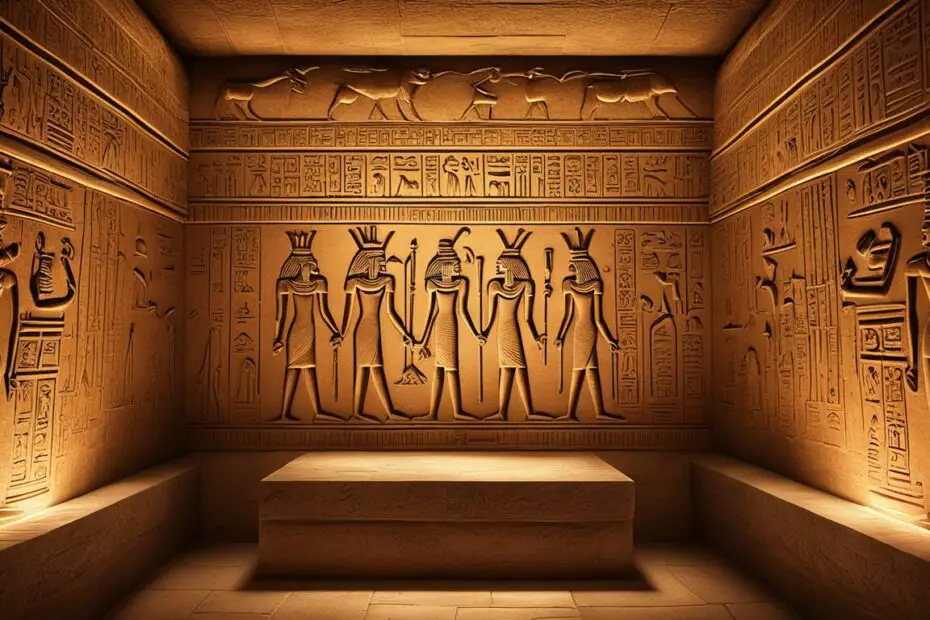King Seti I, the ancient Egyptian pharaoh, is one of the most incredible names in the history of ancient Egypt. His legacy has stood the test of time and his achievements have left an indelible mark on the world. Seti I, also known as pharaoh Seti, was the second ruler of the 19th dynasty of the New Kingdom, and his reign during the prosperous era transformed the face of Egypt.
Born in the city of Avaris, Seti I was the son of Pharaoh Ramsess I and was regarded as the true primal founder of the magnificent Ramesside dynasty. His reign, which lasted between 11 to 15 years, witnessed remarkable accomplishments that continue to fascinate historians and archeologists.
Some of Seti I’s notable achievements include the construction of the Mortuary Temple of Seti I, the Temple at Abydos, and the awe-inspiring Great Hypostyle Hall. These architectural marvels not only showcased his power and grandeur but also served as a testament to his deep reverence for the gods and his commitment to immortalizing his legacy.
Seti I’s military campaigns across Libya and the Levant further solidified his dominance in the region. He launched successful expeditions, expanding Egypt’s territory and influence, and ultimately establishing his capital in the city of Memphis.
Join us as we delve into the intriguing life of King Seti I, exploring his family dynamics, reign, military conquests, and his lasting contributions to ancient Egyptian civilization. Discover the mysteries surrounding his mummy and tomb, and uncover the fascinating details behind the fierce power struggle between Seti II and Amenmesse. Through it all, we will unravel the enigma that is King Seti I, shedding light on his extraordinary legacy that continues to captivate and inspire.
Interesting Facts about King Seti I’s Life
King Seti I, the ancient Egyptian pharaoh, was a remarkable figure in history. Here are some intriguing facts about his life:
- Reign: Seti I’s reign lasted for either 15 years or 11 years, depending on historical sources.
- Relationship: He was famously known as the father of Ramesses II, one of the greatest pharaohs of Egypt.
- Temple Dedication: Seti I had a temple dedicated to Osiris, the god of the afterlife. This temple symbolized his devotion to the Egyptian religion and its deities.
- Architectural Marvel: Seti I was renowned for building the Great Hypostyle Hall in the Karnak Temple complex. This monumental hall featured massive columns and intricate carvings, showcasing the architectural prowess of ancient Egypt.
- Greek Name: Seti I was also referred to by the Greeks as Sethos or Sethosis, highlighting his influence and connection with foreign civilizations.
These fascinating facts shed light on the life and accomplishments of King Seti I, further cementing his status as a legendary ruler of ancient Egypt.
| Fact | Description |
|---|---|
| Reign | 15 or 11 years |
| Relationship | Father of Ramesses II |
| Temple Dedication | Osiris |
| Architectural Marvel | Great Hypostyle Hall |
| Greek Name | Sethos or Sethosis |
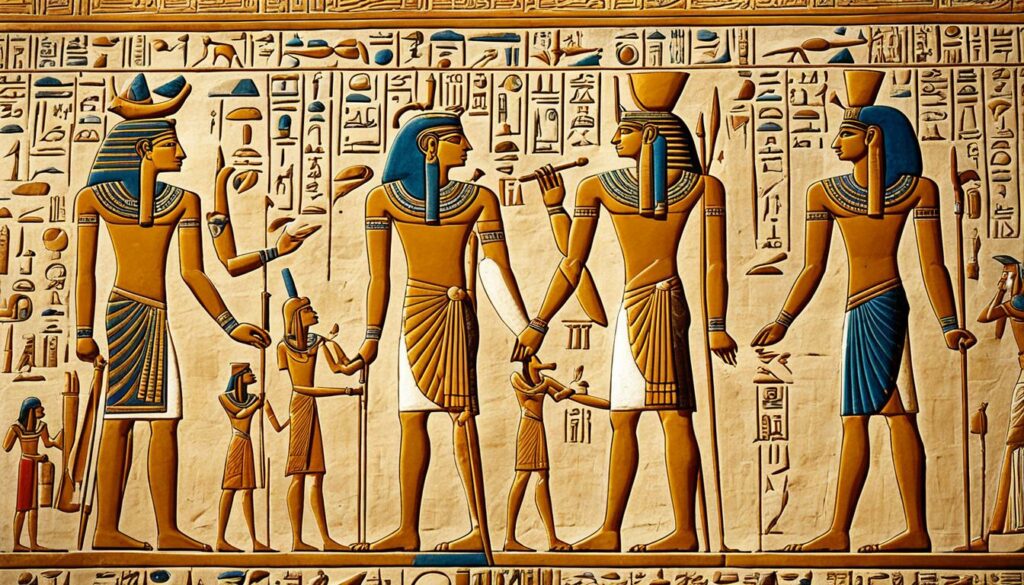
Titles & Names of King Seti I
Throughout his reign, King Seti I held various titles and names that showcased his power and authority. These titles played a significant role in defining his role as a pharaoh and symbolized his connection to the gods. Here are some of the notable titles and names associated with King Seti I:
- Menmaatre: This title represents the divine mandate of pharaohs and translates to “Eternal is the Justice of Ra.”
- Seti-Merneptah: This name combines the names of his father, Ramsess I, and grandfather, Seti-Merneptah, and signifies a continuation of their rule.
- Kanakhte-Khaemwaset Seankhtawy: This title highlights Seti I’s royal lineage and his authority as the ruler of Egypt.
- Wehemmesut-Sekhemkhepesh Derpedjut: This name emphasizes his strength and divinity, translating to “Mighty Bull, Arming the Two Lands.”
- Wehemkhau-Userpedjutem-tawnebu: This title signifies his ability to unite Upper and Lower Egypt and maintain balance and order.
It is important to note that King Seti I was also known by his Greek name, Sethos or Sethosis. This name was given to him by the Greeks and was used in reference to him by foreign civilizations.
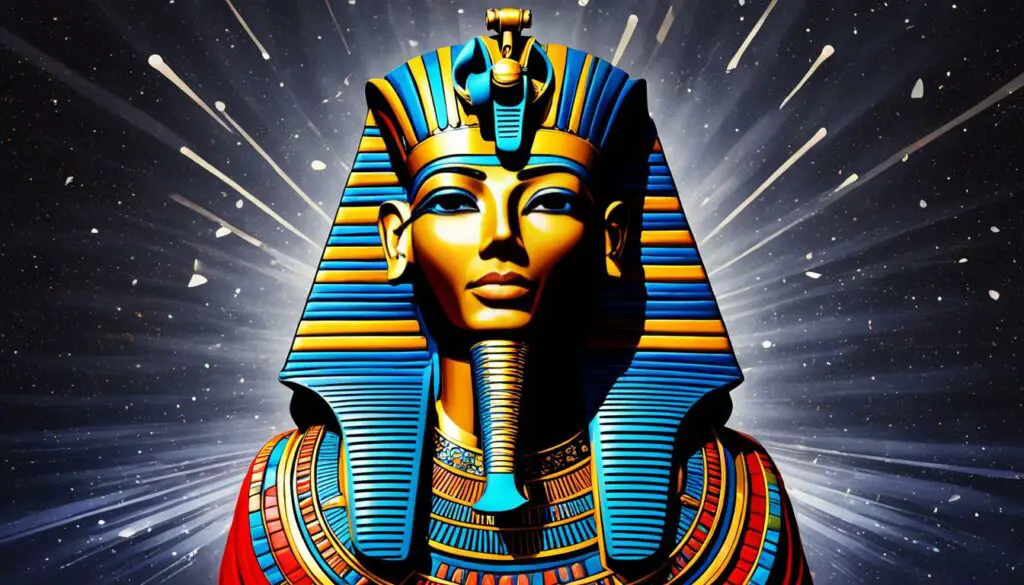
Titles & Names of King Seti I
| Title/Name | Meaning |
|---|---|
| Menmaatre | Eternal is the Justice of Ra |
| Seti-Merneptah | Combination of his father’s and grandfather’s names |
| Kanakhte-Khaemwaset Seankhtawy | Royal lineage and authority as the ruler |
| Wehemmesut-Sekhemkhepesh Derpedjut | Mighty Bull, Arming the Two Lands |
| Wehemkhau-Userpedjutem-tawnebu | Uniter of Upper and Lower Egypt |
Family & Children of King Seti I
King Seti I, the son of Pharaoh Ramsess I and Queen Stire, had a rich family life. His wife, Queen Tuya, played a significant role in his reign, offering support and guidance.
Together, Seti and Tuya had three children, including their eldest son Ramesses II, who would go on to become one of Egypt’s most renowned pharaohs. Ramesses II continued his father’s legacy and expanded Egypt’s empire during his reign.
Seti I’s daughter, Tia, made an influential match, marrying a high-ranking civil servant who happened to share the same name, Tia. This union solidified alliances and reinforced the pharaoh’s power.
Seti I’s youngest son, Ramesses II, succeeded him as pharaoh and married his younger sister, Henutmire. This practice was not uncommon in ancient Egyptian royalty and served to keep the bloodline pure.
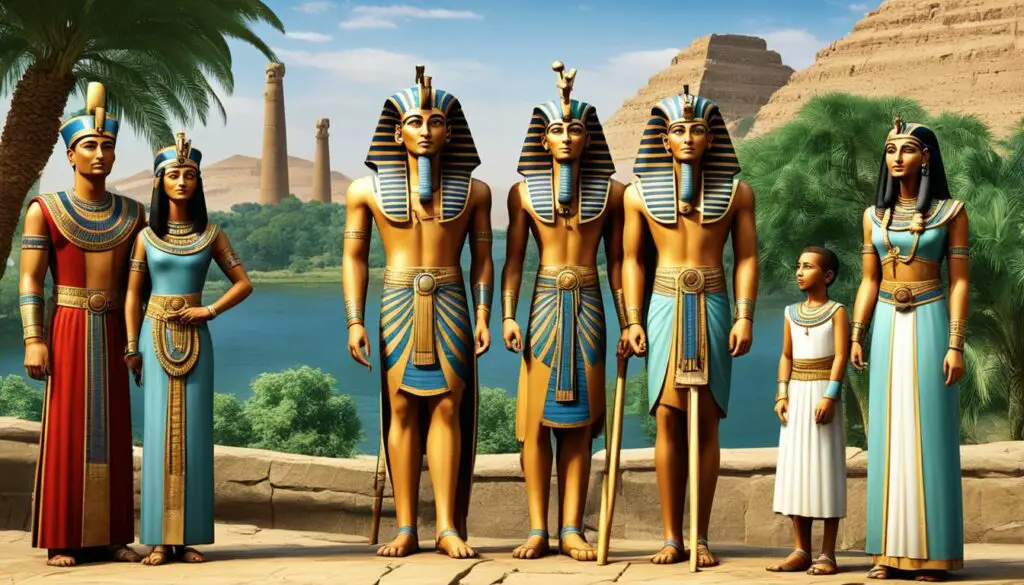
The image above depicts King Seti I with his wife Queen Tuya, his son Ramesses II, and his daughter Tia. It captures the essence of a royal Egyptian family, showcasing their regal demeanor and the prosperity they enjoyed during Seti I’s reign.
| Name | Title |
|---|---|
| Pharaoh Ramsess I | Seti I’s father |
| Queen Stire | Seti I’s mother |
| Queen Tuya | Seti I’s wife |
| Ramesses II | Seti I’s eldest son and successor |
| Tia | Seti I’s daughter |
Reign of King Seti I
During his reign, King Seti I played a pivotal role in restoring order and expanding the Egyptian empire. Seti I’s reign, which lasted between 11 to 15 years in the 19th Dynasty, marked a period of consolidation and growth for Egypt.
Following the chaos caused by Akhenaten’s religious reforms, Seti I focused on reviving traditional beliefs and customs. His efforts to return Egypt to its former glory earned him the reputation of a great reformer and restorer of divine order.
To solidify his reign, Seti I embarked on military campaigns that resulted in victorious conquests. Through these military endeavors, Seti I expanded the boundaries of the Egyptian empire, adding new territories to its domain.
As a strategic move, Seti I established his capital in the city of Memphis. This decision allowed him to centralize control and govern more efficiently. The city became a symbol of his power and authority.
Seti I’s reign left a lasting legacy, demonstrating his prowess as a leader, warrior, and builder. His contributions to the New Kingdom era continue to fascinate historians and archaeologists to this day.
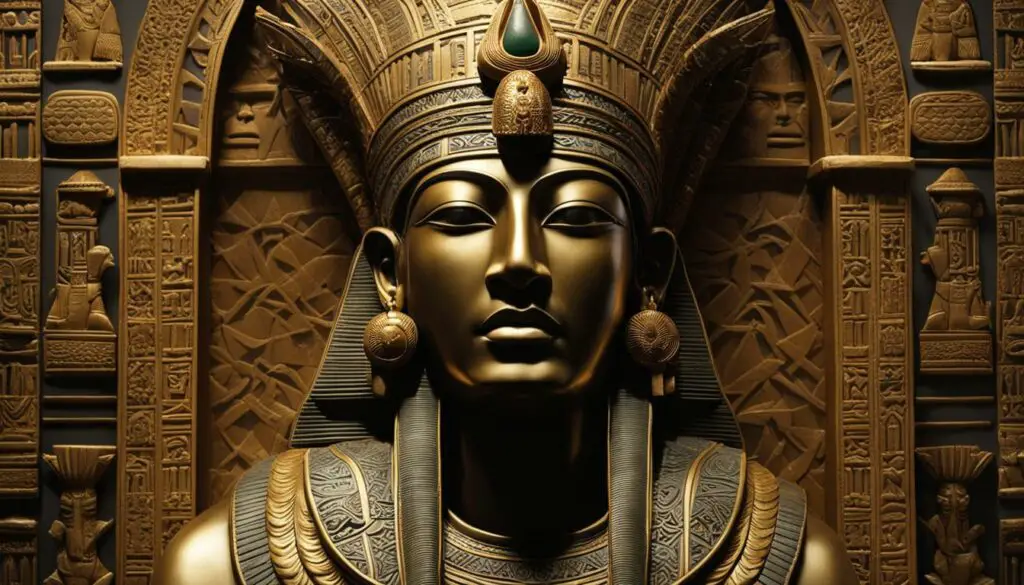
Military Campaigns of King Seti I
King Seti I was a formidable military leader known for his successful campaigns across Libya, western Asia, and Nubia. His military achievements solidified Egypt’s power and expanded its territorial influence.
Defeating the Libyan Tribesmen
Seti I faced a significant threat from the tribes of Libya, who often attacked the Egyptian border. Determined to protect his kingdom, Seti I launched a military campaign against the Libyan tribesmen, successfully quelling their aggression. Through strategic planning and strong leadership, Seti I ensured the security of Egypt’s western borders.
Crushing the Rebellion in Nubia
Seti I also faced a rebellion in Nubia, a region in southern Egypt. The Nubians, led by local chieftains, challenged Egyptian authority and sought to establish their independence. Seti I decisively crushed the rebellion, reasserting Egyptian control over the region and maintaining the unity of his empire.
The military victories and triumphs of Seti I are immortalized in the grand Karnak temple and through royal stelas. These monumental inscriptions depict Seti I’s military exploits, showcasing his prowess as a warrior king. They serve as a testament to his power and the enduring legacy of his reign.
| Key Military Campaigns | Location | Outcome |
|---|---|---|
| Libyan Campaign | Libya | Successful defeat of tribesmen, securing Egypt’s western borders |
| Nubian Rebellion | Nubia | Crushed the rebellion, reestablished Egyptian control in the region |
| Expansion in Western Asia | Western Asia | Increased Egyptian influence and territorial control |
Achievements of King Seti I
King Seti I, the renowned ancient Egyptian pharaoh, left a lasting legacy through his remarkable achievements. After the turbulent period following Akhenaten’s reforms, Seti I restored Egypt’s prestige and greatness. Through his military campaigns, he expanded Egypt’s territory, capturing the legendary city of Kadesh along the way. Seti I’s architectural prowess is evident in the construction of the hypostyle hall at Karnak and the temple at Abydos. Notably, he created the oldest geological map in the world, showcasing his astute observational skills.
| Achievement | Description |
|---|---|
| Military Campaigns | Seti I embarked on successful military campaigns in northern Syria and Palestine, expanding Egypt’s territorial influence. |
| Hypostyle Hall at Karnak | Seti I oversaw the construction of the awe-inspiring hypostyle hall at the Karnak Temple Complex, featuring massive columns and intricate carvings. |
| Temple at Abydos | Seti I built an impressive temple at Abydos, adorned with exquisite relief inscriptions, including the renowned Abydos king list. |
| Capture of Kadesh | Seti I achieved a significant victory by capturing the legendary city of Kadesh, solidifying Egypt’s dominance in the region. |
| Creation of the Oldest Geological Map | Seti I’s meticulous observations and record-keeping led to the creation of the oldest geological map in the world, providing insights into the natural formations of his time. |
Famous Constructions During King Seti I’s Reign
King Seti I was known for his ambitious construction projects that left a lasting legacy in ancient Egypt. Let’s explore some of the famous constructions that were built during his reign.
The Temple of Abydos
The temple of Abydos, built by King Seti I, is a remarkable example of ancient Egyptian architecture. Located in Abydos, the temple is renowned for its beautifully engraved relief inscriptions. One of the most notable features of the temple is the famous Abydos king list, which depicts the names of various pharaohs, including Seti I himself.
The Hypostyle Hall at Karnak
Another magnificent structure built by King Seti I is the great hypostyle hall at Karnak. This colossal hall is famous for its impressive row of 134 columns, each adorned with intricate carvings. The carvings depict the god Atum, further adding to the grandeur and significance of this architectural marvel.
Seti I’s Mortuary Temple
King Seti I’s mortuary temple, located near Qurna on the western bank of the Nile River, is a testament to the pharaoh’s dedication to the afterlife. Although partially ruined, the temple still showcases the immense skill and craftsmanship of ancient Egyptian builders. It served as a place of worship and commemoration for Seti I, ensuring his eternal presence in the hearts of his people.
Key Constructions During King Seti I’s Reign
| Construction | Location | Description |
|---|---|---|
| Temple of Abydos | Abydos | Engraved relief inscriptions and the famous Abydos king list |
| Hypostyle Hall at Karnak | Karnak | 134 columns and carvings depicting Atum |
| Seti I’s Mortuary Temple | Near Qurna | Dedicated to the afterlife of King Seti I |
Death and Burial of King Seti I
King Seti I, also known as Seti I, met a mysterious and unfortunate end. His mummified remains, remarkably well-preserved, bear the traces of a gruesome fate. Seti I’s body was found decapitated, leaving historians to theorize that he may have succumbed to a severe illness that led to this peculiar demise. Nevertheless, his legacy endures beyond his tragic end.
In accordance with ancient Egyptian traditions, King Seti I was laid to rest in the renowned Valley of the Kings. His final resting place can be found in the illustrious tomb known as KV17. This sacred location, discovered by the intrepid explorer Giovanni Belzoni in 1817, stands as a testament to the greatness and eternal memory of King Seti I.
King Seti I’s tomb is a grand testament to his power and status. As the pharaoh of the 19th Dynasty of Egypt’s New Kingdom, he deserved a burial fit for a king. KV17 exemplifies the intricate beauty of ancient Egyptian architecture and the profound cultural significance attached to the burial rituals of their esteemed leaders.
The Fierce Power Struggle: Seti II vs. Amenmesse
During his reign, Seti II found himself embroiled in a fierce power struggle with Amenmesse, a rival king who sought to seize control of Thebes and Nubia. This intense rivalry between Seti II and Amenmesse led to a series of conflicts that had far-reaching consequences for both pharaohs.
As the power struggle intensified, one of the most notable repercussions was the deliberate erasure and vandalism of Seti II’s tombs and monuments by Amenmesse and his supporters. These destructive acts aimed to diminish Seti II’s legacy and solidify Amenmesse’s claim to the throne.
However, despite the challenges he faced, Seti II successfully emerged as the true victor of the power struggle. Through his perseverance and leadership, Seti II managed to restore order and maintain his reign as the rightful pharaoh of Egypt.
Seti II’s Leadership and Achievements
During his reign, Seti II demonstrated strong leadership and made significant achievements that left a lasting impact on ancient Egypt. One notable aspect of his leadership was his willingness to break tradition by elevating Chancellor Bay to the chief state official. This decision showcased Seti II’s ability to recognize talent and delegate authority effectively, contributing to the stability and prosperity of his reign.
Seti II also embarked on ambitious construction projects, particularly in the Valley of the Kings. Although he tragically passed away before these tombs could be completed, his vision and commitment to grandeur are evident in the designs and scale of these structures. Seti II’s grand tombs in the Valley of the Kings stand as a testament to his dedication to preserving the legacy of the pharaohs.
Moreover, Seti II’s wives, Twosret and Takhat, played significant roles in both his personal life and his reign. As influential figures, they provided support and counsel to the pharaoh, ensuring stability and continuity in his rule. Their involvement and contributions to his leadership demonstrate the importance of strong partnerships in ancient Egyptian society.
Seti II’s reign also witnessed advancements in economic and infrastructure development. Under his rule, copper mining in the Timna Valley expanded, contributing to the prosperity of Egypt. Additionally, Seti II oversaw the construction of a barge station in Karnak, enhancing transportation capabilities and facilitating trade and commerce in the region.
FAQ
Q: Who was King Seti I?
A: King Seti I was an ancient Egyptian pharaoh and the second ruler of the 19th dynasty of the New Kingdom. He was also known as Seti-Merneptah and had various other titles and names during his reign.
Q: What are some interesting facts about King Seti I’s life?
A: Seti I was born in the city of Avaris and was the son of Pharaoh Ramsess I. He established his capital in Memphis and launched successful military campaigns across Libya, western Asia, and Nubia. Seti I’s mummy is one of the most preserved in Egyptian history.
Q: What titles and names did King Seti I have?
A: King Seti I had various titles and names during his reign, including Menmaatre, Seti-Merneptah, Kanakhte-Khaemwaset Seankhtawy, Wehemmesut-Sekhemkhepesh Derpedjut, and Wehemkhau-Userpedjutem-tawnebu. His Greek name was Sethos or Sethosis.
Q: Who were the family and children of King Seti I?
A: King Seti I’s wife was Tuya, and he had three children, including his famous son, Ramesses II. His daughter Tia married a high-ranking civil servant named Tia, and his son Ramses II succeeded him as pharaoh and married his younger sister Henutmire.
Q: How long did King Seti I reign?
A: The exact duration of King Seti I’s reign is uncertain, but it is believed to have lasted between 11 to 15 years in the 19th Dynasty of the New Kingdom.
Q: What were King Seti I’s military campaigns?
A: King Seti I launched successful military campaigns across Libya, Levant, and Nubia. He defeated Libyan tribesmen, crushed a rebellion in Nubia, and expanded Egypt’s territory through campaigns in northern Syria and Palestine.
Q: What were some of King Seti I’s achievements?
A: King Seti I’s achievements include the construction of the Mortuary Temple of Seti I, the Temple at Abydos, and the Great Hypostyle Hall. He also captured the legendary city of Kadesh and created the oldest geological map in the world.
Q: What famous constructions were built during King Seti I’s reign?
A: King Seti I built the Temple of Abydos, the Great Hypostyle Hall at Karnak, and his own mortuary temple. The Temple of Abydos contains incredible relief inscriptions, including the Abydos king list, while the Great Hypostyle Hall is known for its 134 columns and carvings depicting Atum.
Q: Where was King Seti I buried?
A: King Seti I was buried in the Valley of the Kings, specifically in tomb KV17. His tomb was discovered by Giovanni Belzoni in 1817.
Q: What was the power struggle between Seti II and Amenmesse?
A: Seti II and Amenmesse engaged in a fierce power struggle, with Amenmesse seizing control of Thebes and Nubia. This rivalry resulted in erasure and vandalism of Seti II’s tombs and monuments.
Q: What were Seti II’s leadership and achievements?
A: Seti II emerged as the true victor in the power struggle with Amenmesse and restored order to the land. He elevated Chancellor Bay to the chief state official, showing a willingness to break tradition and built grand tombs in the Valley of the Kings, although they were not finished before his death.
